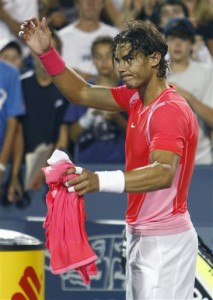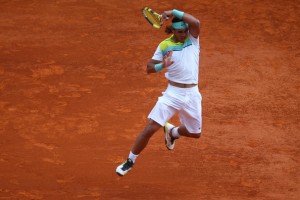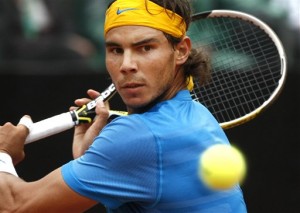The 2011 Australian Open and Rafael Nadal’s Legacy
Rafael Nadal missed a chance at history when he fell short at the Australian Open, one short of having won four Grand Slams in a row.
He’s in good company, though; in the 42 years since Rod Laver’s 1969 season, a long list of greats from Jimmy Connors in 1974 to Roger Federer in 2006-07 had fallen short of that same designation.
It’s hard to imagine Nadal playing any better than he has in last 12 months, just as it’s difficult to see the 29 and a half year old Federer regaining his form from 4-5 years ago.
It is, therefore, unlikely for us to see anyone knocking on that door again anytime soon.
Does missing out on that bit of history, however, make a significant difference in how the Spaniard will be viewed in the record books? Not in my view, unless the injury he sustained is much more serious than indicated.
Natal has already done so much of historical import that missing out on the Rafa Slam is just a loss of increments. The record books already show that, from 2005-07, the most (if not only) dramatic time of the tennis season was the May-July period, when a young Nadal and some soft surfaces were the only things making Federer look somewhat less than invincible.
They will note Nadal’s ungodly, unprecedented record on the clay, how in 2008 he became the first man to win the Channel Slam since Bjorn Borg, then that he did it again two years later. They’ll recall that he took a nation with an already proud tennis history and multiplied its successes many times over, playing an instrumental role in three Davis Cup titles.
And they’ll show that Nadal won three Slams on three surfaces in 2010, making him the first man to win the last three majors in one season since Laver, and the first to win on three different surfaces in one year since Mats Wilander. It’s not the Rafa Slam, but history will regard it nearly as highly.
Provided his recent injury doesn’t derail him for the rest of the season, these records are going to be added onto, also, as the Spaniard remains the favorite to win a sixth Roland Garros crown.
Should he win it, his momentum will likely carry over to a third Wimbledon, tying Boris Becker and John McEnroe.
If history does pass any judgment on his 2011 AO campaign, it may be that this was the moment he stopped winning the majors on the hard courts. It may also be when we realized how special the asphalt-bound majors that he won really were.
Rafael Nadal can no longer be called a “clay court specialist,” as that term as come to mean not so much a surfeit of wins on the dirt as a paucity of success off it. What can be said is that the Spaniard has taken the traditional clay courter’s game – with it’s great defense, boundless patience and stamina, plus the enormously heavy groundstrokes – and placed it in the employ of a one-of-kind athlete, a minority even among professional sportsmen.
These tools have put him on pace to finish his career as the most dominant clay court player ever, and one whose heavy looping forehand and baseline play were still able to concur the grass of England multiple times, and the concrete of New York and Melbourne once each.
With clay removed from the equation, he’d still have put up Hall of Fame-type numbers on the same plane as Jim Courier and Guillermo Vilas (so far). With clay, though, he becomes an all-time great, and should still finish on the same stratosphere as Borg and Roy Emerson.
And it’s clay, and to a lesser extent grass, that can and should help him get there. Just as in 2010, he will enter the clay season off an injury, but one that should have left him sufficiently rested to dominate the dirt again. In a vacuum he’s just as good on hard courts as on grass (he won the Master’s Shield in Canada in 2005 long before he’d adapted to the lawns, after all) but Wimbledon’s position in the calendar allows him to enter at his headiest.
The same can’t be said for Australia and New York.
His only winning campaign in Melbourne in 2009 saw him playing at his highest level, and yet that final weekend required him to put forth the most valiant effort of his career, in back-to-back five-setters that may have ruined the rest of his year. Last year’s US Open win was aided by careful scheduling and a sudden increase in his serving power.
Plus, unlike in prior years, he wasn’t felled by injury or fatigue. As competition from Novak Djokovic, Juan Martin del Potro, and others stiffens, he may not be so lucky next time.
If this is borne out, though, it’s no reason to mourn. Rafael Nadal’s legacy is secure one way or another; if he retires with just two hard court majors to his credit, he’s still a clay court player who successfully adapted his game to hard courts on two occasions.
Successful adaptation is what champions do, and what he’s already done.



Serious follower of the site, several your articles have truly helped me out. Looking towards updates!
It’s actually a cool and useful piece of info. I am glad that you shared this helpful info with us. Please stay us up to date like this. Thank you for sharing.
Tennis is my favorite game and mostly time watching the all matches and feeling fresh. Sometimes math homework can be boring because of probably the big figures and formulas that a student has to use. However, if you break it into smaller amounts, it becomes easier to attend. That means you must also be sober when attending to it.